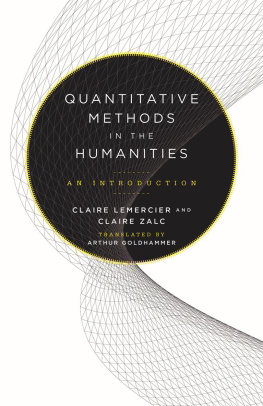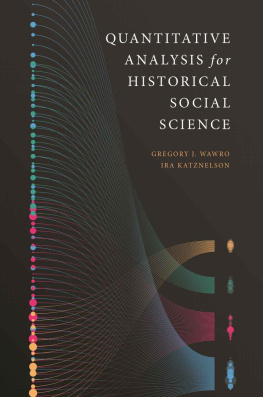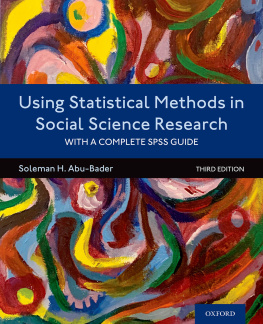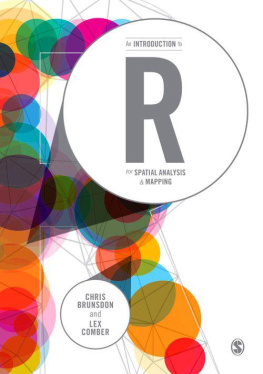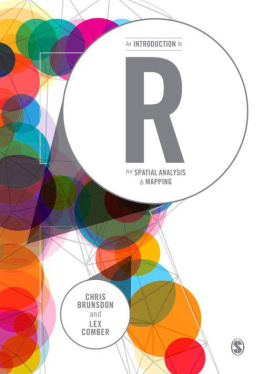Quantitative Methods in the Humanities
Quantitative Methods in the Humanities
AN INTRODUCTION
Claire Lemercier and Claire Zalc
Translated by Arthur Goldhammer
UNIVERSITY OF VIRGINIA PRESS
CHARLOTTESVILLE AND LONDON
University of Virginia Press
2019 by the Rector and Visitors of the University of Virginia
All rights reserved
First published 2019
Library of Congress Cataloging-in-Publication Data
Names: Lemercier, Claire, author. | Zalc, Claire, author. | Goldhammer, Arthur, translator.
Title: Quantitative methods in the humanities : an introduction / Claire Lemercier and Claire Zalc ; translated by Arthur Goldhammer.
Other titles: Methodes quantitatives pour lhistorien. English
Description: Charlottesville : University of Virginia Press, 2019. | Includes bibliographical references and index.
Identifiers: LCCN 2018049781 | ISBN 9780813942681 (cloth : alk. paper) | ISBN 9780813942698 (pbk. : alk. paper) | ISBN 9780813942704 (e-book)
Subjects: LCSH: HistoryMethodology. | HistoryStatistical methods.
Classification: LCC D16.17 .L4613 2019 | DDC 907.2/1dc23
LC record available at https://lccn.loc.gov/2018049781
Cover art: iStock/-strizh-
CONTENTS
Christian Baudelot, Nol Bonneuil, Pascal Cristofoli, Gilles Lemercier, Lise Mounier, Paul-Andr Rosental, Anne Strauss, and Anne Varet-Vitu opened important doors to quantification for us. This book is the result of more than fifteen years of workshops, courses, and summer schools, where we learned enormously while we taught: our warmest thanks to all the participants. An initial, quite different French version was published in 2008, thanks to the excellent Pascal Combemale and Marieke Joly; La Dcouverte kindly reverted the English rights to us. Fellow quantifiers, especially Fabien Accominotti, Pierre Franois, Pierre Merckl, and Carine Ollivier regularly reminded us that some sociologists were interested in history, weird data, and nonstandard methods. Clare H. Crowston and Steven L. Kaplan heartily encouraged us to advance this English version, and made important suggestions on a first draft. We thank the four anonymous reviewers who encouraged us to clarify our ideas and contributed in expanding our references, especially in US history. Danile Fraboulet and Jrme Krop let us use their datasets for two of our examples; we discussed some of the mysteries of R-generated figures with Anton Perdoncin and Nicolas Robette. We acknowledge the financial support for translation provided by the Center for the Sociology of Organizations, the Institute for Early Modern and Modern History, Labex TransferS, and Sciences Po. We thank our employer, CNRS, for freedom in research, and the French scientific community for mostly ignoring the divide between the humanities and social sciences. Finally, this book would not have existed without the enthusiasm and professionalism of our colleague and friend Nicolas Barreyre, our translator Arthur Goldhammer, and our editor Dick Holway and the rest of the team at the University of Virginia Press.
Quantitative Methods in the Humanities
We came to quantitative methods not out of ideological conviction but out of necessity: our sources led us to them, and our arguments relied on them. For us, quantification is not an end in itself but a useful and sometimes necessary tool.
In that spirit, the purpose of this guide is not only to familiarize readers with the various possible uses of quantification in historical practice but also to describe the power and limits of quantitative methods. We hope that our readers will become critical consumers of quantitative research who neither fetishize numbers nor fear them.
This guide is also addressed to anyone who is grappling with historical sources: historians, nonhistorians, students, apprentice researchers, and experienced veterans. We mostly cite historical works, but we are confident that our main arguments are no less applicable to other humanistic disciplines (qualitative social scientists, and even quantifiers, might also be interested). Our ambition is to enable anyone to understand quantitative methods, even if that means deciding eventually, with full understanding, that it is better to do without them. Above all we hope that no one who reads this book will avoid quantitative methods out of ignorance, fear, or denial.
Why Count?
Although history is not an exact science, counting, comparing, classifying, and modeling are nevertheless useful methods for measuring our degree of doubt or certainty, making our hypotheses explicit, and evaluating the influence of a phenomenon. Thanks primarily to advances in microcomputing, every student now has at her disposal calculating capabilities of which researchers could only dream in the 1970s. Yet the learning curve remains steep. Historians are commonly trained as humanists, and many are ambivalent about numbers. Some respect the authority of numbers, but as something alien, without much interest for their own work. Many others disdain measurement as a trivial concern irrelevant to interpretation, or a product of the tyranny of the state or the market. For them, numbers cannot address what matters, namely, people and interpretations, and they may even harm their mission. Articles and books featuring tables and graphs are either rejected outright or accepted without verification: quantification, whether seen as a blemish or a mark of seriousness, is never just a tool like any other.
Furthermore, although new methods appear regularly, these often remain confined within certain disciplines such as sociology or demography. Others are used only in medieval or contemporary history or by followers of Pierre Bourdieu or by colleagues trained in political science even though they might well be applied to sources and problems in other fields. There are, for example, many surprising applications of quantification not just to economic and social history but also to political and cultural history, not just to classes and nations but also to individuals and small groups. A common prejudice, to be sure, divides the social world into phenomena that are suitable for quantification (population distributions, social mobility, etc.) and those that are irreducibly qualitative: conversation, narratives, biography, ethnography, and history often serve as examples. Formalisms clearly can and do apply, however, to these phenomena as well (Tilly 2004). To make these methods accessible, we believe that disciplinary isolation and the compartmentalization of research must be overcome.
We also believe in the circulation of methods between countries and continents. A first version of this book was published in French in 2008. It was written mainly for a French audience, so our discussions often made reference to French works, especially when we walked readers through our own research. In this completely revised English edition, we provide numerous examples of the application of quantitative methods to the history of other parts of the world, especially the United States. Our goal is to encourage debate that transcends specific historical literatures. Quantification is indeed useful in the study of East Asian and West African history as well as West European and North American history; of art and gender history as well as demographic and economic history. We emphasize diversity because we advocate nonstandard approaches to quantification. The risk of standardization has always plagued quantitative history. By contrast, we take the view that different historical literatures rely on different sources and pose different questions, which we regard as opportunities for methodological innovation. Accordingly, we have kept some French references, especially when they were useful to document approaches that are uncommon in the English-speaking literature (such as the historical use of factor analysis). We will use the companion website to this book to gradually expand our list of references to other languages and other parts of the world (https://quanthum.hypotheses.org).

